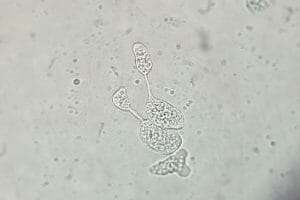Binary fission is a method of asexual reproduction which single-celled organisms, usually prokaryotes, use to create a copy of themselves. Another term for the process is cellular cloning. Mitosis is cell division that results in two identical daughter cells and is primarily used for growth of an organism.
Binary fission is different from mitosis because prokaryotic cells do not have a true nucleus like eukaryotes. Also, there is no mitotic spindle formation in the nucleus during binary fission. However, the processes are similar in that the organism or cell first duplicates its DNA and then divides into two parts in a process known as cytokinesis.
Comparison Chart
| Binary Fission | Mitosis | |
|---|---|---|
| Part of asexual reproduction? | Yes | No |
| Types of cells it occurs in | Prokaryotes | Eukaryotes |
| Formation of mitotic spindles during division? | No | Yes |
| Used for | Reproduction | Overall growth |
| Uses cytokinesis? | Yes | Yes |
Binary Fission
Binary fission is the process by which a single-celled organism creates an exact copy of itself. It doesn’t require finding a mate like in sexual reproduction and it is a faster way to reproduce than sexual reproduction. At around 98.6°F, E. coli cells can divide about every 20 minutes. There are four main types of binary fission based on where the organism divides itself.
Simple
Simple binary fission is used by amoebas and can happen along any plane in the organism.
Transverse
Paramecia and planarians (slime molds) use transverse binary fission. In this method, the division happens along the organisms’ transverse axis. Some types of slime molds can have more than one fission simultaneously and divide into several daughter cells. Slime molds can also use sexual reproduction when necessary, such as to create more genetic diversity in a new environment. Paramecia can switch back and forth the between asexual and sexual reproduction as well.
Longitudinal
Euglenas use longitudinal binary fission where the division occurs along its longitudinal plane.
Oblique
Oblique binary fission is used by organisms in the genus Ceratium (marine dinoflagellates) where the separation occurs obliquely or on a slant.
Process of Binary Fission
Binary fission has steps that are similar to mitosis (see Mitosis section below). The DNA uncoils, duplicates and is pulled to opposite poles in the bacterium in an energy-dependent process. During this time, the organism increases in size to prepare for division. Finally, a cleavage furrow develops in the cell membrane and the two individual cells separate from each other.
Genetic Diversity in Eukaryotes
Eukaryotes can suffer from a lack of genetic diversity due to asexual reproduction via binary fission. Over time, natural selection has pressured these organisms to develop ways to exchange bits of DNA with other organisms to introduce some genetic diversity. The three methods are transformation, transduction and conjugation. In transformation, prokaryotes pick up small pieces of DNA that other prokaryotes have shed into the environment. Transduction occurs as a consequence of the actions of bacteriophages, which can transfer small pieces of DNA from one bacteria to another during the course of infecting them. Finally, in conjugation, bacteria use hair-like structures called pili (singular = pilus) to move small pieces of DNA to other bacteria.

The image above shows the single-celled organism Entamoeba histolytica undergoing binary fission.
Mitosis
The process of mitosis consists of six major steps and results in two identical daughter cells. It is different from meiosis which is used to create sex cells for sexual reproduction. Prior to mitosis beginning, the cell has already copied its chromosomes and the proteins that will create the mitotic spindle were created during the step called interphase.
Prophase
During prophase, the chromosomes coil up tightly and appear thicker. The cells’ nucleolus shrinks in size and disappears. The nuclear membrane starts to break down and the spindle fibers start to form from the proteins created earlier.
Metaphase
Metaphase is characterized by the chromosomes lining up across the midline of the cell and attach to the spindle fibers.
Anaphase
In this phase, each pair of chromatids separates into two identical chromosomes. The spindle fibers then pull each set of chromosomes to opposite ends of the cell.
Telophase
In telophase, the chromosomes unwind and the spindle fibers are broken down. Also in this phase, the nuclear membrane begins to reform.
Cytokinesis
Cytokinesis is when the cytoplasm of the mother cell divides forming two daughter cells. Each daughter cell has DNA that is identical to the mother cell in the number of chromosomes and the genotype.
![]()
The image above shows the steps in mitosis.
References
- Fission (biology). (n.d.). In Wikipedia. Retrieved June 13, 2017 from https://en.wikipedia.org/wiki/Fission_(biology)
- Mitosis. (2017, June 13). In Encyclopedia Britannica online. Retrieved from https://www.britannica.com/science/mitosis
- OpenStax, Biology. OpenStax. May 20, 2013. http://cnx.org/content/col11448/latest/
